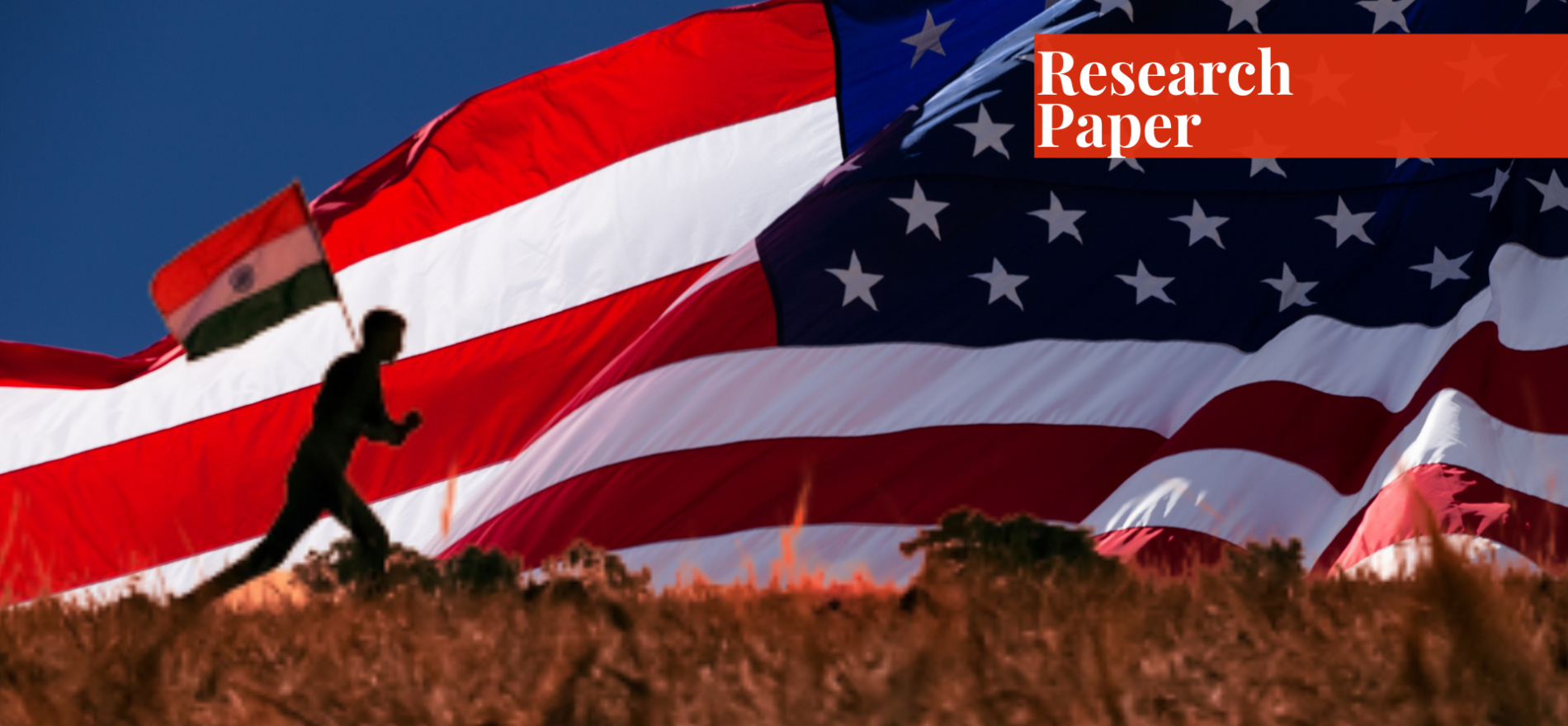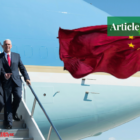Muhammad Abubaker has done his bachelor's in international relations from Bahria University, Islamabad. IHis publications include a piece titled "The emergence of a new Cold War mentality and the role of Quad" and a policy paper titled "The US security leadership in Asia-Pacific and China's countermeasures".
Introduction
After the disintegration of the Soviet Union, remarkable political and strategic changes took place in global politics. The US emerged as the sole superpower in world affairs after the end of the Cold War. India quickly realized the importance of profound changes in the strategic domain and readjusted its foreign policy to work closely with the US. Recognizing the Indian importance, the US reshaped its relations with India as an ally based on the convergence of their interests in South Asia.
Over the period of time, both of them have used different strategic means, techniques, and tools to advance their policy goals in the realm of politics, economics, and military affairs. The strategic bonhomie between the two is based on the US policy to cultivate India as a regional power to contain the influence of rising China. The US views India as a counterforce to China’s growing economic and military might.
Pakistan considers the Indo-US strategic ties against its national interests because India remained hostile towards Pakistan. Modi-led India made clear with its policies, that it would pursue policies that will hurt Pakistan. The close cooperation between the US and India is disturbing the regional strategic stability and creating a security dilemma for China and Pakistan.
Strategic Partners Against China
By improving its relations with India, America is playing a major role in cultivating India as its lever to realize a goal that has become fundamental to its strategy in the post-Cold War era. This goal requires the US to remain firmly embedded in Asian affairs at a time when the continent is emerging as the world’s new center of gravity, and China could be a challenger to the US.
The US policy towards India remained consistent under President Clinton, Junior Bush, Obama, Trump, and everyone enforced their ties with India. We can expect a similar approach towards India under the Biden administration. The US-India strategic partnership is likely to remain strong, to pile pressure on Beijing and to balance its presence in the Indo-Pacific region, to achieve specific goals. In short, the China-centric approach has played an important role in the Indo-US strategic bonhomie.
President George W. Bush was the first one to change the US policy towards China when he came to power back in 2001 and called China a “strategic competitor” rather than a “strategic partner” (Haver, 2021). The same policy was followed by President Obama back in 2011 when he introduced the term “Pivot to Asia”. The clear subtext was to try and manage the rise of China and to frame it, not just as an economic and military rival but also as an ideological one, to shore up western unity against China.
The Trump administration followed a hawkish and aggressive approach towards China that led to the worst deterioration in US-China ties in recent history. He triggered an ongoing trade war, blamed China for the global pandemic, and fostered deeper ties with Taiwan (“US declassified strategy,” 2021). All of these developments, under different US administrations, shifted the regional dynamics.
As a result, new alliances were formed and the Asian region became a center stage for great power politics. India features prominently in the US strategic plans for the region, as evident from the revival of the Quadrilateral Security Dialogue with Japan, Australia, and the US. The US has capitalized on the Indian regional aspirations and effectively used India to advance its strategic goals in Asia vis-à-vis China. Through the strengthening of the US and Indian relations, the US is helping India to become an Asian power, rather than a regional power, to counter the threat of a rising China.
The US-India Defense Pact
The strategic and political realities of the US revolve around confronting China; to achieve this goal it renders India the leading partner role. As a result of the US and Indian relations, the two states have signed different defense agreements to strengthen the capacity and capability of India vis-à-vis China.
To consolidate their strategic alliance and relations, the US and the Indian democracy signed a 10-year defense pact – the “New Framework for the US-India Defense Relationship” – in Washington D.C on June 28, 2005, to strengthen their defense and military ties (Rajghatta, 2005). This landmark agreement was a productive instrument for India to facilitate joint weapons production, the transfer of civil and military technology, and cooperation on missile defense.
The agreement was designed to achieve two main objectives—to help India advance the strategic goals of America, in Asia, and use its relations with the US to become a major world power that may project its military presence beyond the South Asian region. In the current political environment, it is evident that India is advancing the US goals of open and free trade in the Asia-Pacific region, promotion of liberal democracy, projection of rules-based international order, and acting as a counterforce in the face of military and other threats posed by China.
The other important development in bilateral US and Indian relations was the Indo-US civilian nuclear agreement of 2008. The US Congress passed the act titled “The United-States-India Nuclear Cooperation Approval and Nonproliferation Enhancement Act” to align Indian and US policies on nuclear cooperation and nonproliferation and to strengthen their relations (Noor, 2018).
It provided India with an opportunity to improve its nuclear stature and to attain the underlying geostrategic objective of countering China’s growing influence in the region. The US helped India by exerting pressure on the Nuclear Supplier Group (NSG) to allow its nuclear trade with the rest of the world and provided India de facto recognition as a nuclear-weapon state (Noor, 2018). It was a clear violation of the US domestic laws and the provisions of the Non-Proliferation Treaty (NPT).
The first of the quartet agreement between the US and India was the General Security of Military Information Agreement (GSOMIA), which was signed back in 2002. The GSOMIA provides for specific measures to ensure security standards for safeguarding critical information shared by the US with India (“India, US data pact,” 2020).
The US and India signed the second agreement, the Logistics Exchange Memorandum of Agreement (LEMOA) in August 2016. It allowed the two partners to use each other’s military facilities for supplies, spare parts, services, and refueling (Iqbal, 2016). It allowed the US armed forces to operate out of Indian bases to use the LEMOA to counter China’s growing military might, particularly airbases in the South China Sea.
The third foundational agreement, the Communications Compatibility and Security Agreement (COMCASA), was signed in September 2018 (“India, US data pact,” 2020). The agreement allowed India to buy advanced American weaponry and to share sensitive military technology. It allowed India an opportunity to use the US-encrypted communications equipment and systems to communicate through secure networks in peace and war.
The US and India signed the long-pending Basic Exchange and Cooperation Agreement (BECA) in the October of 2020 for geospatial cooperation and have finalized the completion of four pacts of a strategic nature (“US-India agreement,” 2020). BECA will give India access to classified geospatial data, topographic data such as maps, nautical and aeronautical charts, and geodetic, geophysical, geomagnetic, and gravity data (“Indo-US pact undermine regional stability,” 2020).
It will enhance the Indian military’s situational awareness for planning conventional and nuclear strikes. It will also enhance the accuracy of automated systems and weapons like missiles and armed drones. Among, GSOMIA, LEMOA, BECA, and COMCASA, only the Logistics Exchange Memorandum of Agreement is not a one-way transaction, solely benefiting the US (Nasheen, 2021).
The strong US and Indian relations also manifest themself in the former’s support of India’s bid for permanent membership of the United Nations Security Council (UNSC), and its inclusion into the Nuclear Suppliers Group (NSG). Furthermore, it helped India become a member of the Missile Technology Control Regime (MTCR).
The Implications for Pakistan
The Indo-US nexus has severe implications for Pakistan, China, and the region as a whole. The Indo-US strategic cooperation is sowing discord between the regional countries of Asia and threatening regional peace and strategic stability. On the other hand, the extreme competition between the US and China has further complicated the already complex and fraught security environment of Asia.
The intensifying rivalry between the two great powers has put Pakistan in an extremely difficult situation to maintain ties with both of these states. Furthermore, the regional political and strategic landscape has exacerbated the regional insecurities of Pakistan. The US support to India has escalated the nuclear arms race, increased the risk of armed conflict in the region, and decreased India’s incentive to engage in serious dialogue with Pakistan to resolve the long-pending core issues, such as Kashmir.
The Indo-US strategic relations have enabled India to make qualitative and quantitative changes to its nuclear arsenal and gave impetus to a more aggressive Indian military posture. The removal of nuclear-related sanctions and its inclusion into the MTCR has enabled India to acquire dual-use technology to advance its defense program (Noor, 2018).
The ongoing border dispute between China and India, which culminated in an armed conflict at the Ladakh border, has accelerated and deepened the US collaboration with India. As a result, India accelerated its quest to acquire massive armaments, introduced new destabilizing weapons systems in the region, and expanded its nuclear forces.
During the visit of the former US president, Donald Trump, to India in 2020, both sides signed an arms deal worth $3 billion that raised alarms bells in Pakistan. Pakistan’s concerns are legitimate due to India’s aggressive designs in the region, which can further spur the arms race (“Indo-US arms deal,” 2020). The US side also provided India a pair of “predators”—one of the deadliest drones in the world— through the Defense Acquisition Procedure-2020. India could deploy them in Ladakh and the Indian Ocean to monitor the Chinese military and naval activity.
The BECA agreement between the US and India increased Pakistan’s strategic dilemma. It is being presented as part of the efforts to contain China. However, it can affect Pakistan the most through the sharing of top-secret satellite data. It is considered a clear-cut covert spying model to maintain surveillance of Pakistan’s highly sensitive installations (Malik, 2020).
This defense cooperation between the US and India has exposed their sinister designs against Pakistan and China. These efforts are against the spirit of non-proliferation and shed its shadow on the nuclear confidence-building measures. Pakistan is worried because the US side has overlooked Pakistan’s apprehensions, that the delivery of an up-to-date missile defense system, military agreements, and the US backing for India will upset the strategic equilibrium of power in South Asia.
Countermeasures Against the Growing Relations of America and India
To counter the US and Indian strategic alliance and its hegemonic designs in the region, China and Pakistan are diversifying their relations. China proved as a time-tested friend of Pakistan and provided diplomatic, moral, and security assistance to Pakistan to ensure its survivability, territorial integrity, and to maintain the balance of power in South Asia. In addition to protecting Pakistan diplomatically on international forums, China has been the chief arms supplier to Pakistan.
It also helped Pakistan to establish military-industrial complexes like Heavy Industries Taxila (HIT) and Pakistan Aeronautical Complex (PAC), Kamra to lead Pakistan towards development and self-reliance. Across the last few decades, both states have survived the shifting cross-currents of their relations with the US and the Indian democracy which has further reinforced the original rationale for their partnership.
They are continuing their firm support on issues concerning each other’s core national interests. China supports Pakistan’s viewpoint on Kashmir and opposed the Indian political move of 5th August 2019 that complicated the protracted conflict. It also helped Pakistan at international forums like FATF and blocked Indian moves to blacklist Pakistan.
In addition to that, China considers Pakistan as a central part of its transition from a regional power to a global one and has proclaimed the China-Pakistan Economic Corridor (CPEC) as the flagship project of the Belt and Road Initiative (BRI). The other most important aspect is that after the signing of the BECA between the US and India, Pakistan and China decided to further enhance their defense ties.
On 30th November 2020, China’s minister of defense, General Wei Fenghe, and Pakistan’s army chief, General Qamar Javed Bajwa, signed the Pakistan-China Defense Cooperation Pact in Islamabad, paving the way for military cooperation (Aamir, 2020). Pakistan’s military also reduced its reliance on the US-owned Global Positioning System (GPS) and opted for Beidou to neutralize the threat posed by the US-India nexus.
While changing regional alliances, an opportunity arises in the form of Russia for Pakistan. Witnessing the burgeoning US and Indian relations, Pakistan started diversifying its relations with Russia after feeling alienated by the dismissive treatment of the US, considering that it no longer regarded Pakistan as its major ally in the region. Pakistan and Russia expressed their desire to build multi-dimensional relations and inched closer to boosting their defense cooperation. That is evident from the sale of Mi-35 assault helicopters, joint military drill (DRUZHBA), and participation of the Russian navy in a multi-national maritime exercise, Aman-2021.
The war between Azerbaijan and Armenia over Nagorno-Karabakh in 2020, clearly demonstrated the decisive advantage of drones. They proved to be effective, powerful, and low-cost alternatives to conventional weapons. Indians acquired the US and Israeli drones to keep an eye on the Chinese military activity along the Line of Actual Control (LAC).
To counter the Indian threat Pakistan has acquired 50 Wing Loong armed drones from China and has expressed deep interest in acquiring TB2 drones from Turkey. This will be a nightmare for Indian ground formations and will strengthen the defense of Pakistan along the Line of Control (LOC) and working boundary (WB) through enhanced surveillance.
Way Ahead
The developments in the political and strategic arena, particularly in the Asian region, suggest that the cooperation between the US and India will remain strong in the backdrop of the Ladakh conflict. They will further increase their level of engagement in the Indo-Pacific region to challenge the assertive behavior of China through the Quad. At LAC, India and China will try to diffuse their crisis because conflict is not in anyone’s interest. They will try to mend their differences to resume their trade and economic activity, but that will not be an easy task to achieve.
In the current political environment, it is in Pakistan’s interest to work closely with both the US and China simultaneously, without undermining its core national interests. Pakistan is not in a position to rely solely on anyone, it will be a suicidal and disastrous policy. Afghanistan and counter-terrorism are the key areas where it can cooperate with the US.
On the Afghanistan issue, both Moscow and Islamabad agree on the spillover effects of the hasty US and NATO withdrawal—which can lead to hostility, civil war, terrorism, and a refugee crisis in the region. Hence, both states advocate an orderly withdrawal of all foreign forces from Afghanistan because they fear that these issues will transcend the borders and impact every country neighboring Afghanistan.
The Indo-US nexus posed a serious security challenge to Pakistan. Pakistan should deliver its legitimate concerns to the US and to the international community because any conflict in the region will be a serious blow to its core national interests, peace, and strategic stability. It can propose the US to play a constructive role in crisis management and conflict resolution efforts.
Pakistan should also raise the issue of Kashmir and gross human rights violations in the region, with their Indian counterparts, to end the human suffering. The recent ongoing peace talks between India and Pakistan are also a good omen for the region, as they indicate normalcy in the environment of hostility. However, the prospects of peace still remain speculative.
References
- Haver, Z. (2020). American leaders sold a dream of changing China. Foreign Policy. https://foreignpolicy.com/2020/09/29/american-leaders-sold-changing-china-engagement/.
- US declassifies its strategy to use India against China. (2021). TRT World. https://www.trtworld.com/magazine/us-declassifies-its-strategy-to-use-india-against-china-43296.
- Rajghatta, C. (2005). India, US sign defense pact. Times of India. https://timesofindia.indiatimes.com/world/us/india-us-sign-defence-pact/articleshow/1155838.cms.
- Noor, S. (2018). Ten years of the Indo-US civilian nuclear agreement: Implications for Pakistan. South Asian Voices. https://southasianvoices.org/ten-years-indo-us-civilian-nuclear-agreement-implications-pakistan/.
- Nasheen, S. (2021). US policy of containment against China. Paradigm Shift. https://www.paradigmshift.com.pk/us-policy-of-containment-against-china/.
- India, US sign military data pact; China slams Pompeo’s visit. (2020). Dawn. https://www.dawn.com/news/1587349.
- Iqbal, A. (2016). US-India defense pact to impact Pakistan, China. Dawn. https://www.dawn.com/news/1280873
- US-India agreement (2020). Dawn. https://www.dawn.com/news/1587758.
- Indo-US pact could undermine region’s stability: Experts. (2020). Dawn. https://www.dawn.com/news/1590079.
- Indo-US arms deals. (2020). Dawn. https://www.dawn.com/news/1537331.
- Malik, R. (2020). The BECA pact; a serious threat. The Nation. https://nation.com.pk/03-Nov-2020/the-beca-pact-a-serious-threat.
- Aamir, A. (2020). China and Pakistan ink military MOU to counter US-India pact. Nikkei Asia. https://asia.nikkei.com/Politics/International-relations/China-and-Pakistan-ink-military-MOU-to-counter-US-India-pact.
If you want to submit your articles and/or research papers, please check the Submissions page.
The views and opinions expressed in this article/paper are the author’s own and do not necessarily reflect the editorial position of Paradigm Shift.



















